
In 2024, the logistics industry is poised for significant transformation driven by technological advancements, a focus on sustainability, and the continued growth of e-commerce. Companies will need to adapt to these changes by embracing innovation, enhancing supply chain resilience, and leveraging data to make informed decisions. The integration of advanced technologies and collaborative platforms will be essential for staying competitive in this dynamic landscape.
Brief Overview of Logistics Providers
1PL (First-Party Logistics)
- Definition: A company that handles its own logistics operations internally.
- Example: A manufacturer using its own fleet to transport goods.
2PL (Second-Party Logistics)
- Definition: A business that provides basic transportation services, such as shipping, for other companies.
- Example: A trucking company hired to move goods from one location to another.
3PL (Third-Party Logistics)
- Definition: A company that offers outsourced logistics services, which can include transportation, warehousing, and distribution.
- Example: A logistics provider managing a company’s entire supply chain operations.
4PL (Fourth-Party Logistics)
- Definition: A logistics provider that manages resources, technology, infrastructure, and other 3PL services to design and implement comprehensive supply chain solutions.
- Example: A consulting firm coordinating multiple 3PL services for optimal supply chain management.
5PL (Fifth-Party Logistics)
- Definition: A company that focuses on the management of networks of supply chains, often leveraging advanced technologies such as blockchain, AI, and IoT.
- Example: A logistics provider that orchestrates the entire logistics ecosystem for e-commerce businesses using data-driven strategies.
The Future of Logistics in 2024
Technological Advancements
- AI and Machine Learning: Enhanced predictive analytics for demand forecasting, route optimization, and supply chain visibility.
- Blockchain: Increased transparency and security in supply chains, improving traceability of goods.
- IoT: Real-time tracking of shipments, improving inventory management and reducing losses.
Sustainability Focus
- Green Logistics: Emphasis on reducing carbon footprints through electric vehicles, eco-friendly packaging, and optimized routes.
- Circular Supply Chains: Implementing practices to reuse and recycle materials, minimizing waste.
E-commerce Growth
- On-Demand Delivery: Expansion of last-mile delivery solutions to meet consumer expectations for fast and flexible delivery options.
- Omnichannel Logistics: Integration of online and offline channels to provide seamless shopping experiences.
Supply Chain Resilience
- Risk Management: Development of more robust risk management strategies to mitigate disruptions caused by geopolitical issues, pandemics, and natural disasters.
- Diversification: Sourcing from multiple suppliers and regions to reduce dependency on single sources.
Automation and Robotics
- Warehouse Automation: Increased use of autonomous robots for picking, packing, and sorting in warehouses.
- Delivery Drones: Exploration of drone delivery services to improve efficiency and reach in urban and remote areas.
Data-Driven Decisions
- Big Data Analytics: Leveraging large datasets to gain insights into consumer behavior, inventory levels, and operational efficiency.
- Digital Twins: Creating virtual models of the supply chain to simulate and optimize processes.
Collaborative Platforms
- Logistics Marketplaces: Platforms connecting shippers with logistics providers to streamline operations and reduce costs.
- Shared Economy: Utilization of shared resources, such as warehouse space and transportation, to improve efficiency and reduce costs.
